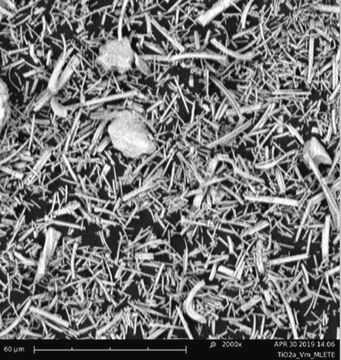248576
Titan(IV)-oxid, Anatase
powder, −325 mesh, ≥99% trace metals basis
Synonym(e):
Titandioxid
About This Item
Empfohlene Produkte
Beschreibung
contains ∼5% rutile
Qualitätsniveau
Assay
≥99% trace metals basis
Form
powder
Partikelgröße
−325 mesh
Durchschnittlicher Durchmesser
45 μm
mp (Schmelzpunkt)
1825 °C (lit.)
Dichte
3.9 g/mL at 25 °C (lit.)
SMILES String
O=[Ti]=O
InChI
1S/2O.Ti
InChIKey
GWEVSGVZZGPLCZ-UHFFFAOYSA-N
Suchen Sie nach ähnlichen Produkten? Aufrufen Leitfaden zum Produktvergleich
Allgemeine Beschreibung
Anwendung
Lagerklassenschlüssel
13 - Non Combustible Solids
WGK
nwg
Flammpunkt (°F)
Not applicable
Flammpunkt (°C)
Not applicable
Persönliche Schutzausrüstung
dust mask type N95 (US), Eyeshields, Gloves
Hier finden Sie alle aktuellen Versionen:
Besitzen Sie dieses Produkt bereits?
In der Dokumentenbibliothek finden Sie die Dokumentation zu den Produkten, die Sie kürzlich erworben haben.
Kunden haben sich ebenfalls angesehen
Artikel
A Review of Mesoporous TiO2 Thin Films
Electronically, it behaves as a wide band gap (3.2 eV) semiconductor and exhibits memristor properties.2 Optically, TiO2 has high opacity with a very high refractive index3 (>2.4), and it exhibits strong absorbance in the UV range.
Thermoelectric Performance of Perovskite-type Oxide Materials
The prevailing strategies for heat and electric-power production that rely on fossil and fission fuels are having a negative impact on the environment and on our living conditions.
Unser Team von Wissenschaftlern verfügt über Erfahrung in allen Forschungsbereichen einschließlich Life Science, Materialwissenschaften, chemischer Synthese, Chromatographie, Analytik und vielen mehr..
Setzen Sie sich mit dem technischen Dienst in Verbindung.



